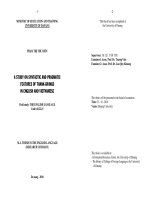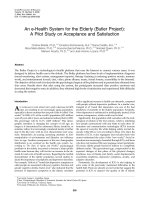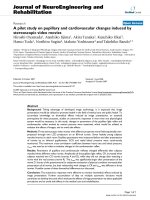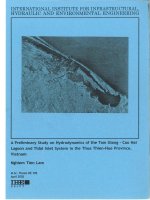A preliminary study on diversity and community structure of phytoseiid mites associated with medicinal plants in selected locations of telangana
Bạn đang xem bản rút gọn của tài liệu. Xem và tải ngay bản đầy đủ của tài liệu tại đây (1016.54 KB, 11 trang )
Int.J.Curr.Microbiol.App.Sci (2021) 10(03): 974-984
International Journal of Current Microbiology and Applied Sciences
ISSN: 2319-7706 Volume 10 Number 02 (2021)
Journal homepage:
Original Research Article
/>
A Preliminary Study on Diversity and Community Structure of Phytoseiid
Mites associated with Medicinal Plants in Selected Locations of Telangana
Md. Iftiar Hossain Molla, Priyankar Mondal, Suvash Ch. Bala* and Krishna Karmakar
Department of Agricultural Entomology, Bidhan Chandra Krishi Viswavidyalaya,
Mohanpur, West Bengal-741252, India
*Corresponding author
ABSTRACT
Keywords
Phytoseiidae,
Diversity,
Medicinal Plants,
Telangana,
Community
structure, Mite
fauna
Article Info
Accepted:
10 February 2021
Available Online:
10 March 2021
In the present study, an investigation was carried out to explore the
diversity and community structures of phytoseiid mite fauna associated
with medicinal plants in four selected locations viz. Ananthagiri, CSIRCIMAP campus, Kotapally and Eturangaram sanctuary situated in
Southern, Northern and Central agroclimatic zones of Telangana. A total of
515 specimens were collected during the present survey belonging to 8
genera and 13 species of which Euseius alstoniae (23%), Amblyseius
largoensis (22%), Euseius ovalis (15%), Euseius astrictus (6%) and
Phytoseius kapuri (2%) were the most abundant species. Comparing all the
survey locations, Eturangaram sanctuary with natural vegetation of
medicinal plants revealed maximum diversity of species whereas scanty
vegetation of Ananthagiri hills yielded the least diversity of phytoseiid
mites.
Introduction
Telangana state is a newly formed southern
region state of India, created by bifurcating
Andhra Pradesh state on 2nd June 2014. The
total geographical area of Telangana state is
112.07 lakh hectares, of which 23.89 % area is
covered by forest and about 43.20 % area is
under cultivation (Bhargavi, 2017). Over 2000
species of medicinal plants are found in
Telangana state (Singh and Vidyasagar, 2015).
Telangana State Medicinal Plant Board has
implemented various scheme to encourage the
farmers for cultivation of medicinal plants in
the farm through subsidies and also train the
people for collection of medicinal plants from
the forest land for upkeeping the livelihood of
the tribal people and helps in marketing the
products (Sivaramana and Kumar, 2018).
According to the World Health Organization,
80% of the population in the developing
countries depends upon the traditional and
974
Int.J.Curr.Microbiol.App.Sci (2021) 10(03): 974-984
herbal medicines in their primary healthcare
(Pramanik, 2004). Indeed, several modern
drugs are manufactured from phytochemicals
extracted from plants with medicinal
importance. Healthy plant material is therefore
essential for maintaining product quality.
However, both quality and quantity are
adversely affected by the damage of
phytophagous insect and mite pests and
diseases during their growth and development.
2004; Gupta and Karmakar, 2011 and Haneef
and Sadanandan 2013). Due to insufficient
information available concerning phytoseiid
mite fauna associated with medicinal plants in
the state of Telangana, the present
investigation was carried out to explore the
diversity of phytoseiid mite complex on
medicinal plants found in selected locations of
this state.
Materials and Methods
The mites belonging to the family
Phytoseiidae (Mesostigmata) and Cheyletidae,
Cunaxidae, Stigmaeidae, Bdellidae, Tydeidae,
and Anystidae (Prostigmata) are plants
inhabiting pro-active predators to soft-bodied
insects and phytophagous mite pests in agrihorticultural crops all over the world. Among
the entire predatory mite group, phytoseiids
are the most important and commercially
exploited owing to their high searching
capacity, good adaptability to a wide
environmental condition, short life span
(1week approx.) and high multiplication
capability (40-60 off-springs per female)
(Gerson et al., 2003). Under the vision of
sustainable farming, these predators can be
utilised in the biological control and integrated
pest management strategies against different
crop pests. Therefore, it is utterly important to
know about the diversity of various phytoseiid
mite species to employ effective pest
management
strategies
for
cultivated
medicinal crops. Till now the family
Phytoseiidae contains more than 2,400 species
worldwide (Demite et al., 2018) and every
year new species are being added to this list.
Faunistic studies on Phytoseiidae of the
country have been explored since the 1960s.
More than 235 species of Phytoseiidae are
described and reported from India (Karmakar
and Gupta, 2014; Pramanik and Karmakar,
2016; Karmakar et al., 2017 and Karmakar
and Bhowmik, 2018) of which only a few
species has been reported to be associated
with medicinal plants so far (Lahiri et al.,
Study area
Locations for collecting phytoseiid mites
associated with medicinal plants from the
three different agro-climatic zones of
Telangana were nominated based on the
availability of required vegetation and also
because these locations represent overall agroclimatic features of the respective zones.
Kotapally
from
Northern
Telangana,
Eturangaram
Sanctuary
from
Central
Telangana, Ananthagiri and CSIR-CIMAP
from Southern Telangana were selected for the
current investigation (Figure 1). Edagatta
forest and nearby localities (18055’40”N,
79049’12”E;
18056’1”N,79048’53”E;
0
0
18 55’58”N,79 49’28”E) in Kotapally; forest
areas near Warangal- Eturangaram road and
Burgampadu-Eturangaram road (18018’31”N,
80025’25”E
18018’57”N,
80025’1”E
0
0
18 18’20”N, 80 24’40”E) in Eturangaram
sanctuary; vegetations near Vikarabad-Tandur
road and birding site (17018’42”N, 77051’5”E;
17018’50”N, 77051’58”E) of Ananthagiri hills
forest and medicinal plant garden of CSIRCIMAP (17025’34”N, 78034’45”E) were
selected to collect the specimens of phytoseiid
mites during the present survey.
Collection and preservation of specimens
The phytoseiid mite fauna harbouring on
different species of medicinal plants as well as
medicinally important forest plants were
975
Int.J.Curr.Microbiol.App.Sci (2021) 10(03): 974-984
examined by making extensive surveys
covering different locations of Telangana
province during February 2020. Phytoseiid
mites are generally bigger in size and fastmoving in nature.
They were collected directly from the plant
with the help of fine camel hairbrush (size
000) and then preserved in 70% alcohol until
permanent slides were prepared. Besides, a
direct beating method was adopted i.e., simply
beating the plant parts over black cardboard
and the dislodged mites were collected by
using a single hairbrush.
The mite specimens were preserved in a
separate small plastic vial containing 70%
alcohol mentioning the name of the host and
the location. Besides the targeted phytoseiid
fauna, the associated phytophagous mite and
soft bodied insects were also collected and
identified as potential prey for documented
phytoseiid predators though direct feeding of
these prey species was not observed during
present investigation.
Type specimens of the collected species are
presented in plate 1.
Statistical analysis
To understand the diversity and community
structure of different phytoseiid mite species
in selected locations the number of specimens
for each species was enumerated reflecting the
species richness (S) and the following
diversity and evenness indices were calculated
based on the formulae provided by ShannonWeiner (1963)and Simpson (1949):
Shannon’s diversity index (H)
=
;
where the p is the proportion (n/N) of
individuals of one particular species found (n)
divided by the total number of individuals
found (N), ln is the natural log, Σ is the sum of
the calculations, and s is the number of
species. The effective number of species
(ENS) of each location was calculated taking
the exponential of H.
Identification of specimens
Simpson’s index (D)
The specimens were brought to the Acarology
laboratory (All India Network Project on
Agricultural Acarology), Department of
Agricultural Entomology, Bidhan Chandra
Krishi Viswavidyalaya, West Bengal. The
collected mite specimens were poured in a
cavity block and mounted on modified
Berlese’s medium for identification. Then the
slides were dried in an oven at 400-450 C for 7
days.
= 1−
The mites were examined with a phase and
differential interference contrast microscope
(BX 53, Olympus) and the phytoseiid species
were identified following the keys provided by
Chant & McMurty (2007). The specimens
collected for the present study are deposited in
Acarology laboratory of the same institute.
;
where N stands for the total number of
individuals in a community and n stands for
the number of individuals of a particular
species. Species evenness was calculated from
Pielou’s evenness index (E)
Pielou’s evenness index (E)
=
;
where H is Shannon’s diversity index and s is
the total number of species in the surveyed
area (Pielou, 1975). The coefficient of
similarity between the surveyed locations was
estimated based on the Sorenson’s coefficient
(CC)
976
Int.J.Curr.Microbiol.App.Sci (2021) 10(03): 974-984
Sorenson’s coefficient (CC)
=
;
Where C is the number of species the two
communities have in common, S1 is the total
number of species found in community 1, and
S2 is the total number of species found in
community 2 (Sorenson, 1957).
Results and Discussion
A total of 515 specimens of Phytoseiid mites
belonging to 8 genera and 13 species were
collected from the natural and cultivated
vegetations of medicinal plants in Ananthagiri,
Kotapally, CSIR-CIMAP and Eturangaram
sanctuary located in different agroclimatic
zones of Telangana (Table 1). Diversity and
proportional abundance of the phytoseiid
species in selected locations are presented in
figure 2. The phytoseiid community structures
of these areas are furnished in Table 2 and 3.
Sampling in the Eturangaram sanctuary
revealed highest species richness (S=9) among
the four survey locations followed by
Kotapally and CSIR-CIMAP with S=8 and
Ananthagiri with S=7.
Also, the Eturangaram sanctuary had the
highest diversity of Phytoseiid species in
terms of H=1.76 with moderate species
evenness of 0.80 and 6 effective number of
species but lowest D=0.76 which reflects an
environment highly favourable for few species
while not so favourable for others. Amblyseius
largoensis was the dominant species (40%) in
this region followed by Euseius alstroniae
(21%) and Euseius ovalis (15%). Surprisingly,
4 species of phytoseiids viz. Asperoseius
jujubae, Phytoseius jujubae, Neoseiulus
longispinosus and Paraphytoseius orientalis
were found only in Eturangaram sanctuary
among the surveyed locations. Despite having
similar species richness, Kotapally had higher
diversity in terms of H=1.70, ENS=8, D=0.80
and E=0.83 in comparison to the CSIRCIMAP which exhibited the indices as 1.65, 5,
0.79 and 0.79 respectively. Compared to the
natural vegetation of Kotapally, medicinal
plants sampled in the campus of CSIRCIMAP are artificially maintained in
agroecosystems which may lead to the
reduction of species diversity in this location.
The number of plants surveyed was also less
in CSIR-CIMAP campus than the surveyed
area of Kotapally which may be another
reason for reduced diversity in this
area.Amblyseius
largoensis
and
Typhlodromips syzygii were the dominant
species (25% each) in Kotapally followed by
Amblyseius brachycalyx (20%) and Euseius
alstoniae (15%). Present survey in CSIRCIMAP campus revealed the highest diversity
of Euseius alstoniae (33%) followed by
Euseius ovalis (25%) and Euseius astrictus
(19%). Surprisingly, a single specimen of
Euseius sundarbanensis was discovered from
CIMAP which was not reported earlier from
Southern India.
Community structure of Phytoseiid species in
Ananthagiri hills revealed lowest species
diversity in terms of H=1.60, ENS=5, D=0.77
and E=0.82 probably due to less vegetation in
the surveyed areas. Euseius ovalis (30%) was
the predominant species in this region
followed by Typhlodromips syzygii (28%) and
Euseius alstoniae (24%).
The Sorenson's coefficient revealed extremely
high community overlap or similarity between
the species complex of Ananthagiri and
Kotapally followed by a moderately high
overlap of species complex between Kotapally
and CSIR-CIMAP.
At the same time, the species complex of
Eturangaram sanctuary when compared with
Kotapally, Ananthagiri and CSIR-CIMAP
exhibited the lowest coefficient reflecting very
less overlap between these communities.
977
Int.J.Curr.Microbiol.App.Sci (2021) 10(03): 974-984
Table.1 Diversity of Phytoseiid mite fauna associated with different medicinal plants in selected
locations of Telangana
Location
Name of host plants
Name of Phytoseiid
species
Potential prey found
during survey
Ananthagiri
(Southern
Telangana)
Millettia pinnata
Vachellianilotica
Ricinus communis
Alstoniascholaris
Tabernaemonta
nadivaricata
Bougainvillea glabra
Nerium oleander
Anacardium occidentale
Cocos lucifera
Earleaf acacia
Tecoma stans
Azadirachta indica
Limoniaacidissima
Sapindusmukorossi
Earleaf acacia
Senna auriculata
Catharanthus roseus
Phoenix dactylifera
Santalum album
Mangifera indica
Ziziphus mauritiana
Ficus racemosa
Holarrhenapubescens
Ocimum sanctum
Manilkara zapota
Citrus aurantifolia
Moringa oleifera
Mangifera indica
Annona reticulata
Psidium guajava
Carica papaya
Senna auriculata
Terminalia arjuna
Millettia pinnata
Emblica officinalis
Manilkara hexandra
Butea monosperma
Cyperus rotundus
Amblyseius brachycalyx
Karmakar, Bhowmik &
Sherpa, 2017
Amblyseius largoensis
(Muma, 1955)
Euseius alstroniae (Gupta,
1975)
Euseius astrictus
Karmakar & Bhowmik,
2018
Euseius ovalis (Evans,
1953)
Bemisia tabaci
Number of
collected
specimens of
Phytoseiid mites
3
Raoiella indica
4
Eriophyid sp.
23
Eriophyid sp.
9
Tetranychusurticae,
Polyphagotarsonemus
latus
Tetranychus urticae
29
Tetranychus
macfarlanei
27
Polyphagotarsonemus
latus,
Tetranychus urticae
Tetranychus urticae,
Tetranychus
macfarlanei,
Eriophyid sp.
Polyphagotarsonemus
latus,
Bemisia tabaci
-
44
Tetranychus
macfarlanei
-
12
Polyphagotarsonemus
latus
Eriophyid sp.
-
53
Kotapally
(Northern
Telangana)
Phytoseius kapuri (Gupta,
1969b)
Typhlodromips syzygii
(Gupta, 1975)
Amblyseius brachycalyx
Karmakar, Bhowmik &
Sherpa, 2017
Amblyseius largoensis
(Muma, 1955)
Euseius alstroniae (Gupta,
1975)
Euseius astrictus
Karmakar & Bhowmik,
2018
Euseius ovalis (Evans,
1953)
Phytoseius kapuri (Gupta,
1969b)
Typhlodromips syzygii
(Gupta, 1975)
Typhlodromus
978
2
54
42
4
3
4
Int.J.Curr.Microbiol.App.Sci (2021) 10(03): 974-984
CIMAP
(Southern
Telengana)
Eturangara
m sanctuary
(Central
Telengana)
Ocimimamericanum
Ocimumbasillicum
Morus alba
Cassia fistula
Cleistanthuscollinus
Hibiscus rosa-sinensis
Psidium cattleyanum
Ficus religiosa
Alangiumsalviifolium
Ficus religiosa
Artocarpus
heterophyllus
Nycthanthesarbortristis
Bougainvillea glabra
Calophylluminophyllum
Monoonlongifolium
Psidium guajava
Simarouba glauca
Sapindusmukorossi
Leucaena leucocephala
Murrayakoenigii
Azadirachta indica
Withaniasomnifera
Aegle marmelos
Mimusopselengi
Curcuma longa
Justicia adhatoda
Bombax ceiba
Melia dubia
Ocimum sanctum
Tamarindus indica
Ricinus communis
Bougainvillea glabra
Tecoma stans
Spathodeacampanulata
Limoniaacidissima
Earleaf acacia
Catharanthus roseus
Mangifera indica
Ziziphus mauritiana
Manilkara zapota
Moringa oleifera
Psidium guajava
Senna auriculata
(Anthoseius) sp.
Amblyseius brachycalyx
Karmakar, Bhowmik &
Sherpa, 2017
Amblyseius largoensis
(Muma, 1955)
Euseius alstroniae (Gupta,
1975)
Euseius astrictus
Karmakar & Bhowmik,
2018
Euseius ovalis (Evans,
1953)
Euseius sundarbanensis
Karmakar & Bhowmik,
2018
Phytoseius kapuri (Gupta,
1969b)
Tetranychus ludeni
5
Polyphagotarsonemus
latus
Eriophyid sp.
1
22
Bemisia tabaci
13
Polyphagotarsonemus
latus
-
17
Tetranychus urticae
1
Typhlodromus
(Anthoseius) sp.
Polyphagotarsonemus
latus
7
Amblyseius largoensis
(Muma, 1955)
Asperoseius jujubae
Karmakar & Bhowmik,
2018
Euseius alstroniae (Gupta,
1975)
Tetranychus ludeni
54
-
6
Polyphagotarsonemus
latus,
Eriophyid sp.
-
28
Tetranychus urticae
20
Euseius astrictus
Karmakar & Bhowmik,
2018
Euseius ovalis (Evans,
1953)
979
1
3
Int.J.Curr.Microbiol.App.Sci (2021) 10(03): 974-984
Butea monosperma
Morus alba
Cassia fistula
Hibiscus rosa-sinensis
Monoonlongifolium
Murrayakoenigii
Azadirachta indica
Ocimum sanctum
Carica papaya
Paraphytoseius orientalis
(Narayanan, Kaur &Ghai,
1960)
Phytoseius kapuri (Gupta,
1969)
Polyphagotarsonemus
latus
5
Eriophyid sp.
4
Phytoseius jujubae (Gupta,
1977)
Neoseiulus longispinosus
-
5
Tetranychus ludeni
10
Table.2 Community structure of Phytoseiid mite species associated with Medicinal plants in
selected locations of Telangana
Sampled
communities
Ananthagiri (C1)
Kotapally (C2)
CSIR-CIMAP (C3)
Eturangaram
sanctuary(C4)
Species
richness
(S)
7
8
8
9
Shannon
Index (H)
ENS
Simpson’s
Index (D)
Pielou’s
Index (E)
1.60
1.70
1.65
1.76
5
8
5
6
0.77
0.80
0.79
0.76
0.82
0.83
0.79
0.80
Fig.1 Survey locations in three agroclimatic zones of Telangana (Map modified from
/>
980
Int.J.Curr.Microbiol.App.Sci (2021) 10(03): 974-984
Table.3 Species overlap between selected Phytoseiid communities associated with medicinal
plants of Telangana
C1C2
0.93
C1C3
0.8
C1C4
0.63
C2C3
0.87
C2C4
0.60
C3C4
0.60
Fig.2 Diversity and proportional abundance of Phytoseiid species in Telangana
981
Int.J.Curr.Microbiol.App.Sci (2021) 10(03): 974-984
Plate.1 Representatives of the phytoseiid fauna collected from the medicinal plants of
Telangana: A. Amblyseius brachycalyx, B. Amblyseiuslargoensis, C. Asperoseius jujubae, D.
Euseius alstroniae, E. Euseius astrictus, F. Euseius ovalis, G. Euseiussundar banensis, H.
Neoseiulus longispinosus, I. Paraphytoseius orientalis, J. Phytoseius jujubae, K. Phytoseius
kapuri, L. Typhlodromips syzygii
982
Int.J.Curr.Microbiol.App.Sci (2021) 10(03): 974-984
In the present investigation, Amblyseius
largoensis, Euseius alstoniae, Euseius ovalis,
Euseius astrictus and Phytoseius kapuri were
found as the most common species comprising
respectively 22%, 23%, 15%, 6% and 2% of
the total specimens which reflects a
considerably high abundance of these species
across all the selected locations of Telangana.
Among the other species, Typhlodromips
syzygii (16%) collected from Ananthagiri and
Kotapally and Amblyseius brachycalyx (10%)
collected from Ananthagiri, Kotapally and
CSIR-CIMAP
exhibited
a
moderate
abundance. These predatory mites were found
to be associated with number of herbivore
mite
and
insect
species
such
as
Polyphagotarsonemus latus, Raoiella indica,
Tetranychus spp. Eriophyid species, Bemisia
tabaci etc. but exact predator-prey relationship
was not established. Tetranychus spp. and
Polyphagotarsonemus latus were found to be
most abundant and potential prey species
during this survey.
The present study reflects an overall diversity
and abundance of phytoseiid mites associated
with different medicinal plants of Telangana.
The natural vegetations of Eturangaram forest
in Central Telangana zone reflected the
highest diversity and species richness
followed by the natural vegetations of
Kotapally in Northern Telangana Zone. The
outcomes of this investigation will serve as
one of the most important references for future
faunistic studies of phytoseiid mites in
Telangana. However, further survey and
sampling in these regions are required to
explore and describe the unknown and
rediscover the known species of phytoseiid
mites associated with medicinal and other
economically important plants and predator
prey
relationship
with
associated
phytophagous mite and insect species requires
to be thoroughly investigated for formulating
effective biological control modules.
Acknowledgement
The authors are grateful to Vice-Chancellor,
Bidhan Chandra Krishi Viswavidyalaya and
Co-ordinator, All India Network Project on
Agricultural
Acarology
for
providing
necessary funds and facilities for this study.
The first author is grateful to Pavan Thakoor
from Department of Agricultural Entomology,
BCKV for his support during the survey in
Telangana.
References
Bhargavi, P. H., 2017. Implementation of EPOS and Aadhaar Enabled Fertilizer
Distribution System; A Case Study of
Rangareddy District, Telangana State.
Amity
Journal
of
Media
&
Communications Studies 1; 7(1).
Chant, D. A. and McMurtry J. A., 2007.
Illustrated keys and diagnosis for the
genera and sub genera of the
Phytoseiisdae of the world (Acari
Mesostigmata). Indira Publishing
House, Michigan, U.S.A. 220 pp.
Demite, P. R., deMoraes, G. J., McMurtry, J.
A., Denmark, H. A. and Castilho, R. C.
2018.
Phytoseiidae
Database.
Available
online
at:
www.lea.esalq.usp.br/
phytoseiidae
(Accessed June 09, 2019).
Gerson, U., Smiley, R. L. and Ochoa, R.,
2003. Mites (Acari) for pest control.
Oxford: Blackwell Science.
Gupta, S. K. &Karmakar, K., 2011. Diversity
of mites (Acari) on medicinal and
aromatic plants in India. Acarology
XIII Proceedings of the International
Congress, Zoosymposia 6:504pp.
Haneef, S. and Sadanandan, M. A., 2013.
Survey of predatory mites (Acari:
Phytoseiidae)
associated
with
economically important plants of north
Kerala. In Biological Forum-An
International Journal 5(2): 119-122pp.
983
Int.J.Curr.Microbiol.App.Sci (2021) 10(03): 974-984
Karmakar, K. and Bhowmik, S., 2018.
Description of eight new species and
re-description
of
four
species
belonging to the family Phytoseiidae
(Acari: Mesostigmata) from West
Bengal, India. Zootaxa, 4422(1): 041–
077.
Karmakar, K. and Gupta, S. K., 2014.
Description of four new species of
phytoseiid
mites
(Acari:
Mesostigmata) from West Bengal.
Records of zoological Survey of India,
114(4): 687-700.
Karmakar, K., Bhowmik, S. and Serpa, C.,
2017. Description of five new species
and redescription of two species of
Amblyseius (Acari: Phytoseiidae) from
West Bengal, India. Zootaxa, 4311(1):
39-61.
Lahiri, S., Podder, S., Saha, G. K. and Gupta,
S. K., 2004. Diversity of phytophagous
and predatory mites occurring on
medical plants in Kolkata metropolis.
Proceedings of the Zoological Society,
57(1):47-52.
Pielou, E. C., 1975. Ecological Diversity.
Chap. 1. Wiley, New York
Pramanik, P., 2004.VeshajaUdvid O Bharat.
In: Proceedings seminar medicinal
plants. Narendrapur. 52-59pp.
Pramanik, S. and Karmakar, K.,2016.
Description of six new species of
phytoseiid mites (Acari: Phytoseiidae),
from Arunachal Pradesh, India. Persian
Journal of Acarology, 5(3), 161-187.
Shannon, C. E. and Wiener, W., 1963. The
mathematical
theory
of
Communication University. Urbana:
Illinois Press.
Simpson, E. H., 1949. Measurement of
diversity. Nature, 163(4148):688.
Singh, P. S. and Vidyasagar, G. M.,
2015.Cultivation,
Marketing
of
Medicinal and Aromatic Plants from
Telangana: A Review. Journal of
Medicinal Plants Studies, 3(5):76-9.
Sivaramane, N. and Kumar, R., 2018.
Consultancy Project on Exploring
Potential
for
Medicinal
Plants
Cultivation in Telangana, ICARNational Academy of Agricultural
Research Management and Telangana
State
Medicinal
Plants
Board,
Hyderabad, 34pp.
Sörensen, T. 1948. A method for establishing
groups of equal amplitude in plant
sociology based on similarity of
species content and its application to
analyses of the vegetation on Danish
commons.-K. danskevidensk. Selsk.
Skr. Biol. Skr., 5(4): 1-34.
How to cite this article:
Md. Iftiar Hossain Molla, Priyankar Mondal, Suvash Ch. Bala and Krishna Karmakar. 2021. A
Preliminary Study on Diversity and Community Structure of Phytoseiid Mites associated with
Medicinal Plants in Selected Locations of Telangana. Int.J.Curr.Microbiol.App.Sci. 10(03):
974-984. doi: />
984









